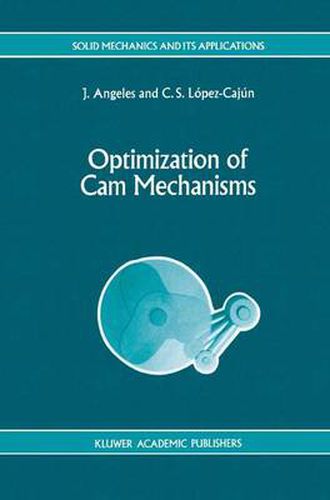Optimization of Cam Mechanisms
J. Angeles,C.S. Lopez-Cajun

Optimization of Cam Mechanisms
J. Angeles,C.S. Lopez-Cajun
This title is printed to order. This book may have been self-published. If so, we cannot guarantee the quality of the content. In the main most books will have gone through the editing process however some may not. We therefore suggest that you be aware of this before ordering this book. If in doubt check either the author or publisher’s details as we are unable to accept any returns unless they are faulty. Please contact us if you have any questions.
- 1 Preliminary Concepts A cam mechanism is a mechanical system consisting of three basic components: a driving element, called the cam; a driven element, termed the follower; and a fixed frame. Sometimes, an intermediate element is introduced between the cam and the follower with the purpose of improving the mechanism performance. This element is called the roller because function is to produce a pure-rolling relative motion be tween the cam and the follower. The purpose ofa cam mechanism is the transmission of power or information. In applications concerning power transmission, the main good to be transmitted is force or torque; in applications ofinformation transmission, the main good transmitted takes the form of motion signals. Most modern appli cations of cam mechanisms, to be described shortly, are of the former type. Cam mechanisms used for information transmission were traditionally found in measuring instruments. With the advent ofmodern microprocessor-based hardware, this typeof application is becoming less common. Nevertheless, cam mechanisms are still used in a wide spectrum of applications, especially in automatic machines and instruments, textile machinery, computers, printing presses, food-processing equipment, internal combustion engines, control systems, and photographic equipment (Prenzel, 1989). In the design of cam mechanisms, the engineer performs several activities, namely, task definition, synthesis, analysis, optimization, and dynamic simulation. These tasks do not always follow this order. In fact, some loops may appear in the foregoing tasks, such as those illustrated in Fig. 1. 1. 1.
This item is not currently in-stock. It can be ordered online and is expected to ship in 7-14 days
Our stock data is updated periodically, and availability may change throughout the day for in-demand items. Please call the relevant shop for the most current stock information. Prices are subject to change without notice.
Sign in or become a Readings Member to add this title to a wishlist.


